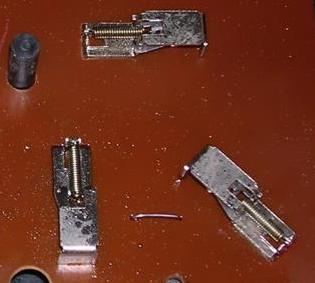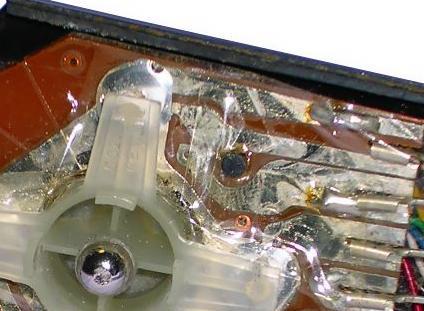Chapter 8: Joysticks
There are two types of joysticks: Analog and digital.
Analog joysticks are giving analogue signals to computer.
Computer's ADC (Analog-to-digital converter) has to translate the voltage
changes to data which is read ad joystick's deflection in some axis. Usually two
(horizontal and vertical) ADCs are used. These joysticks were popular with Apple
II clones and some other American computers but are not used in Commodre or
Atari line.
They use trimmers to change the resistance according to angle of a stick. The
voltage drop across a resistor is dependent not only on resistor value, bu on a
current we draw. So the same analog joystick on two dofferent computers (with
different ADC applications) may work with different sensitivity.
The other type of joystick is a switch-based joystick. It is
commonly used in game consoles and 8-bit microcomputers. It has 4 switches for
left, right, up and down, another switches for "Fire" buttons. Moving joystick
to the left activates the "left" switch. Moving left-up closes two switches.
Actions performed by these joysticks are read by at least 5 digital inputs
(Left, Right, Top, Bottom and Fire). In these joysticks the most important thing
is to close the switch in proper moment linking the input to e.g. ground.
Nothing more. And they can record only that the stick has been moved in a
direction, not how much it has been moved.
Some computers in joystick ports have 5V output too, it can be used to power
e.g. auto-fire circuit which presses the "fire" button automatically. Such
circuit is toggled on using a switch in joystick.
There are few types of switches used in joysticks and if you
can't see the internals the best method of identifying what is inside is by
sound made by it when switch is activated (stick moved in a direction):
|
1. Large microswitches
Larger microswitches used in rotating programming devices or as end
detection switches are here used in detecting stick movements, they
rarely fail but are large and noisy. Rarely used in joysticks and
usually only in special joysticks for arcade gaming machines or other
embedded applications. Sometimes they can be seen in DIY joysticks. If
they fail, a switch may be replaced or in some cases disassembled to
fix. These switches are well described in the
Wikipedia article.
Identification: Large, rigid units emitting significant metallic click
with accompanying sounds like a spring is squeezed.
2. Small microswitches
Small microswitches called"tact switches" can be used in joysticks.
Unfortunately by high forces acting on a button they may fail as
microswitches in mice. If so, they need replacement as they cannot be
fixed.
These joysticks can be identified by sound - after moving the stick they
emit very quiet click of a microswitch.
3. Spring-based switches (picture on the right)
A frame with a lever is installed on a PCB. Lever is kept by spring to
it. When the spring is pressed, it the lever moves and hits the contact.
Quite reliable until it is in one piece. Usually it only requires
cleaning. If it is incomplete, parts from another mechanism would be
needed.
When activated, emits very characteristic and loud metallic click.
|
 |
 |
4. Rubber pads
As with rubber pads based keyboard, a small rubber dome with conductive
top is pressed to short metal tracks in PCB. Prone to wear and
pollution.
Emits no sound when activated5. Metal pads (picture on the left)
As rubber pads, but more durable and harder to replace - small metal
domes pressed to short a circuit.
Sound is similar to microswitch one, the same level but more metallic.
When restoring a joystick first make the stick move in all directions
smoothly. After fixing the mechanism and stick keeping springs, clean
the PCB and switches as usually they are dirty. You can check a
switch-based joystick using ohmmeter or a computer, there are also some
dedicated
joystick testers which make sound and light a LED when specific
switch is pressed.
Advanced joysticks have Auto-fire circuit or even stopwatch powered
by internal batteries or from computer's power unit. These circuits have
to be tested as all electronic parts.
Analog joysticks can be diagnosed using ohmmeter if you know their
pinout. |
MCbx, 2016



